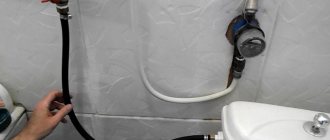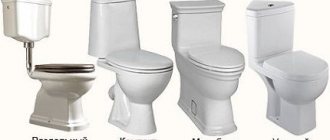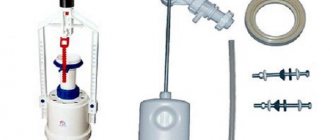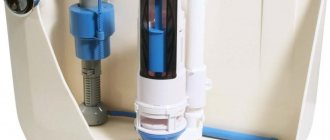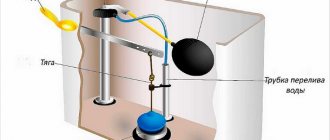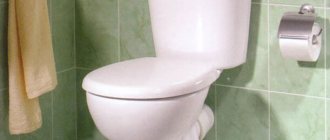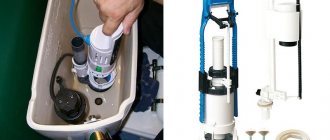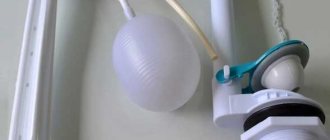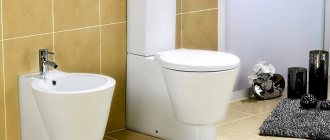No matter how high-quality the toilet and fittings are, problems arise from time to time: either water does not fill, or, on the contrary, it constantly flows from the drain. All these problems are associated with fittings (drain and inlet valves), which are placed in the drain tank. Next, we’ll talk about how to install, change, adjust and repair it yourself, with your own hands.
No matter what the toilet looks like, the filling in the cistern will be similar
Internal organization
The toilet cistern consists of two simple systems: collecting water and draining it. To troubleshoot possible problems, you need to understand how everything works and works. First, let's look at what parts the old-style toilet cistern consists of. Their system is more understandable and visual, and the operation of more modern devices will be clear by analogy.
The internal fittings of this type of tank are very simple. The water supply system is an inlet valve with a float mechanism. The drain system is a lever and a bulb with a drain valve inside. There is also an overflow tube - it drains excess water from the tank, bypassing the drain hole.
Old design cistern design
The main thing in this design is the correct operation of the water supply system. A more detailed diagram of its device is shown in the figure below. The inlet valve is connected to the float using a curved lever. This lever presses on the piston, which opens/closes the water supply.
When filling the tank, the float is in the lower position. Its lever does not press on the piston and it is pressed out by water pressure, opening the outlet to the pipe. The water is gradually filling up. As the water level rises, the float rises. Gradually it presses the piston, cutting off the water supply.
The device of the float mechanism in the toilet tank
The system is simple and effective; the filling level of the tank can be changed by bending the lever slightly. The disadvantage of this system is the noticeable noise when filling.
Now let's look at how draining water in a tank works. In the version shown in the figure above, the drain hole is blocked by the drain valve bulb. There is a chain attached to the bulb, which is connected to the drain lever. We press the lever, lift the bulb, the water drains into the hole. When the level drops, the float moves down, opening the water supply. This is how this type of cistern works.
Modern models with lever flush
There is less noise when filling toilet tanks with bottom water supply. This is a more modern version of the device described above. Here the tap/inlet valve is hidden inside the tank - in a tube (in the photo there is a gray tube to which the float is connected).
Drain tank device with water supply from below
The operating mechanism is the same - the float is lowered - the valve is open, water flows. The tank filled, the float rose, and the valve shut off the water. The drainage system remained almost unchanged in this version. The same valve that rises when you press the lever. The water overflow system has hardly changed either. This is also a tube, but it goes into the same drain.
You can clearly see the operation of the drain tank of such a system in the video.
With button
Models of toilet tanks with a button have similar water inlet fittings (some with side water supply, some from the bottom). Their drain fittings are of a different type.
Tank device with push-button drain
The system shown in the photo is most often found in domestically produced toilets. It is inexpensive and reliable. The design of imported units is different. They basically have a bottom water supply and another drain and overflow device (pictured below).
Imported fittings for the cistern
There are different such systems:
- with one button the water is drained while the button is pressed;
- draining starts when pressed, stops when pressed again;
The working mechanism here is slightly different, although the principle remains the same. In this fitting, when you press the button, the glass rises, blocking the drain. The stand remains motionless. In short, this is all the difference. The drain is adjusted using a rotary nut or a special lever.
How to remove a toilet cistern
Depending on the model, the method of attaching the tank may differ.
For example, the container can be mounted separately from the toilet, to the wall. But most often the tank is attached to the top of the toilet with two or three studs and bolts, the diameter of which is 5-7 mm. On top of the toilet there is a special shelf on which a container of water is installed.
To dismantle the old drive, proceed according to the following scheme:
- shut off the water supply to the plumbing fixture;
- unscrew the hose through which water is supplied to the container;
- empty the tank of water by pressing a button;
- unscrew the button head, and then remove the drive cover;
- the remaining water is removed with a regular sponge;
- unscrew the nuts located under the toilet shelf, these nuts
- screwed onto bolts or studs, they are what hold the water container.
After completing all these steps, the storage container is carefully lifted and separated from the toilet.
In some cases, the rubber gasket sticks strongly, so some effort is required to remove it.
Installation and replacement of cistern fittings
A significant part of toilet problems can be solved by adjusting or replacing the tank fittings. In any case, you need to know how to disassemble and assemble the insides of the tank. This skill will definitely come in handy. When replacing, you first need to dismantle the old device and then install the new one. We will describe in detail the entire process, including the installation of new fittings.
How to remove the cap from the tank
If a flush tank with a button is being repaired, it is not always immediately clear how to remove the lid. This is easy to do: press the button and turn the ring.
How to remove the lid from a tank with a button
If you can’t press the button with your fingers, examine its inner rim. There are two special slots there. You can take a screwdriver with a narrow end and use it to turn the ring a little. Then you can unscrew it with your fingers.
After this, remove the button by pulling it up. That's it, the lid can be lifted.
Removing the tank
To replace the old cistern fittings, it must be removed from the toilet bowl. First of all, turn off the water supply, then drain the water from the tank. Then, using wrenches, remove the water supply hose (it is attached to the side or bottom).
When the water supply is located at the bottom, it is located next to the mounting studs
Next, you need to disconnect the tank from the toilet bowl. If you look underneath it, you can see bolts that are tightened with nuts. So we unscrew them using a set of open-end wrenches or an adjustable wrench. Before doing this, place a container or a rag near the toilet - a certain amount of water always remains in the tank, and when you unscrew the nuts, it will drain.
After unscrewing two nuts - on the right and on the left, we remove the tank. There is usually a gasket left on the bowl. If it has become deformed or dried out, it is also advisable to replace it.
Remove the drainage tank from the bowl
Place the tank on a flat surface. There is a large plastic nut at the bottom. It holds the drain mechanism, we unscrew it. Sometimes the first turns have to be made using an adjustable wrench, but do not over-tighten it - the plastic can be brittle.
Unscrew the nut holding the drain mechanism
Now the water drainage mechanism can be easily removed.
This is what the cistern fittings look like after several years of operation.
Similarly, remove the water supply mechanism. With bottom feed, the fastening nut is also located at the bottom (right or left of center).
Water supply mechanism fastening nut
This was the removal of the water supply device to the tank
After that, we look inside the drain tank. Usually, rusty sediment, small metal particles, sand, etc. accumulate at the bottom. All this must be removed and, if possible, washed. The inside must be clean - any debris caught under the gaskets can cause a leak. After this, we begin the installation of new fittings.
Installation of cistern fittings
Everything happens in reverse order. First, we install a new drain mechanism stand. We unscrew the plastic nut from it and put a rubber gasket on the pipe. It can be white (as in the photo) or black.
We put a rubber gasket on the thread
Place the device inside the container and screw the plastic nut on the outside. We twist it as far as possible with our fingers, then tighten it a little with a wrench. You can't overtighten it - it will burst.
Install and tighten the nut
Sealing
Now on the toilet bowl we replace the o-ring that seals its connection with the flush cistern. Dirt and rust often accumulate in this place - we wipe it off first, the seat should be dry and clean.
Install the O-ring
We install mounting bolts inside the tank, not forgetting to put gaskets. We put the drain tank in place until it can be leveled. The main thing is to get the screws and the outlet part into the seats. Take a washer and nut and screw them onto the screws.
Tighten the fastening
When both nuts are installed, but not yet tightened, level the container. Then, using a wrench, we begin to tighten the fastening. We turn it a few turns, first from the right, then from the left.
Install the exhaust valve
Lastly, install the inlet valve for the drain tank. It could have been installed earlier, but then it would be inconvenient to install the mounting bolts - there is too little space. We also put a gasket on the outlet pipe, then install it inside and secure it with a nut.
Tighten the intake valve mounting nut
The next step is to connect water to the same pipe. Before connecting the flexible water hose, open the water for a while, giving the opportunity to remove scale, which accumulates every time after closing the tap, even for a short time. After draining a certain amount of water (place a bucket so as not to wet the floor), connect the hose to the fitting (turn off the water again).
Connecting water to the toilet tank
Although the fitting is metal, there is no need to tighten this connection too much - first with your fingers, then one turn with a wrench. If you notice drops when you turn on the water, you can tighten it another half turn. After this, we check whether the system is working correctly. If everything is correct, install the cover and screw the button. You can test it again. This completes the installation of the drain tank fittings. As you can see, everything can be done with your own hands.
General information. Types of drain containers
The following types of drainage tank are distinguished. Flush models differ in the type of installation with the toilet bowl and the requirements for installation work.
Types of drains:
- 1. Compact type drain. The tank is sold as a set, bolted to the shelf of the toilet bowl, and after completion of installation work it forms a single plumbing device. Assembly of this type is considered the simplest and is an economical option.
- 2.Autonomous, hinged type of tank. The container is attached to the wall above the bowl, and the toilet is connected to the cistern using a drain pipe leading from the cistern. Flushing is carried out not by pressing a button, but by using a rope or lever.
- 3. Built-in view of the drain tank. This type of cistern was designed specifically for toilets that have a wall-hung bowl. The toilet is built into the wall of the toilet, the flush tank is located behind it on a frame, which is installed behind a false wall, the flush button is placed outside. This plumbing fixture is equipped with a dosed drain.
Adjustment and repair
When using the toilet, problems periodically arise - sometimes it flows, sometimes, on the contrary, water does not fill into it. Sometimes, tired of the inconvenience, people buy new toilets. But in vain. Most faults are resolved in 10-20 minutes. Moreover, everything is so simple that anyone can do it. You don't have to call a plumber. You can do everything yourself.
Adjusting the water level
We will talk about devices with bottom water supply. After installation, the toilet cistern must be adjusted. By default, they come from the factory set to the maximum amount of water in the container. This amount is often excessive. With the help of simple adjustments we can reduce the volume of water in the tank. For this:
- Turn off the water supply and drain the water.
- Unscrew the button.
- Remove the cover.
Where is the adjustment screw located?
- There is a plastic screw on the float mechanism. By unscrewing/twisting it we change the amount of water. If you need to reduce the amount of water, tighten the screw, lowering the float down. The next time you fill (you can turn on the water), the water level should drop.
- Reinstall the cover and button.
The same procedure is necessary if water is constantly leaking from the tank. One of the reasons is that the float is raised too high. Because of this, water flows through the overflow system.
With a side water supply and a float mechanism, adjustment is even simpler - we change the position of the float by bending its lever. On the one hand it is simpler, but on the other hand it is more difficult. You have to bend it many times to achieve the required level.
By bending the float lever we change the water level in the drain tank
Toilet tank is leaking
If the water in the toilet constantly leaks and its level is normal, we move on. There are several reasons for this leak. And if so, then the methods of elimination will be different.
- The rubber seal under the drain valve in the tank has silted up, dirt has gotten under it, and a groove (or several) has appeared on its surface. The method of treatment is to clean the existing gasket or replace it with a new one. To resuscitate the old one, you need to: turn off the water, drain it,
- remove the drain mechanism by unscrewing the plastic nut from below;
- pull out the drain valve, remove and examine the gasket, clean it of settled particles, if necessary (there are grooves), sand it with very fine sandpaper until smooth;
- install it in place, connect everything and check operation.
- The trigger mechanism itself was demolished. To check whether this is the case, you can lightly press the mechanism with the cover removed. If the leak stops, that means this is the problem. If it still leaks, you should try cleaning the gasket (described above) or replacing it. If the flow stops when pressed, you can replace the fittings or make the glass heavier.
Where to put the weighting agent
To do this, remove the release mechanism and place something heavy in its lower part. This could be several pieces of metal, a sock filled with pennies, sand, etc. We install the device in place and check the operation.
Operating principle of toilet fittings
All shut-off valves work according to the following principle.
As soon as the drain valve opens after pressing the button or lifting the lever head, water leaves the tank and the float in it drops.
In turn, the float bulb is connected through a lever or rod to a locking mechanism, the passage channel of which is blocked by an elastic rubber valve.
As a result of the float lowering, the valve moves, opening the channel, and water begins to flow into the tank. As soon as the water level reaches a certain point, the previously constantly moving valve finally closes the passage channel and the access of water to the tank stops.
Built-in tank: installation features
This plumbing equipment differs from others in that it has a special frame frame on which the toilet and cistern are mounted. After the installation is installed, it is covered with sheathing, such as plasterboard, tiles or plastic, wood panels.
The built-in tank is mounted according to the following scheme:
- it is determined at what height the frame frame will be fixed in relation to the sewerage system, water supply, floor and wall. Subsequently, the frame is fixed either to wooden blocks, or attached directly to the wall strictly according to the level;
- markings are made on the surface of the floor and wall and the points where the fastening elements will be located are marked;
- using an impact drill or hammer drill, drill holes at the designated points. The depth of the holes and their diameter must correspond to the size of the dowels that will be inserted into these holes;
- the frame frame is securely fixed to both the floor and the wall using anchor bolts. Fastening elements must securely fasten the metal frame so that it does not move under load;
- elements of plumbing equipment are mounted on the installed frame frame - sewer siphon, toilet, cistern;
- the toilet is hermetically connected to the sewer system, and the storage tank is connected to the water supply;
- the frame frame is hidden under some finishing material; For ease of finishing, the toilet must be dismantled. At the end, a flush button is inserted and the toilet is fixed to the frame.
This is a general diagram for installing a built-in tank. Depending on the selected toilet model, the installation diagram may change, so it is important to study the installation instructions and strictly adhere to them during installation work.
